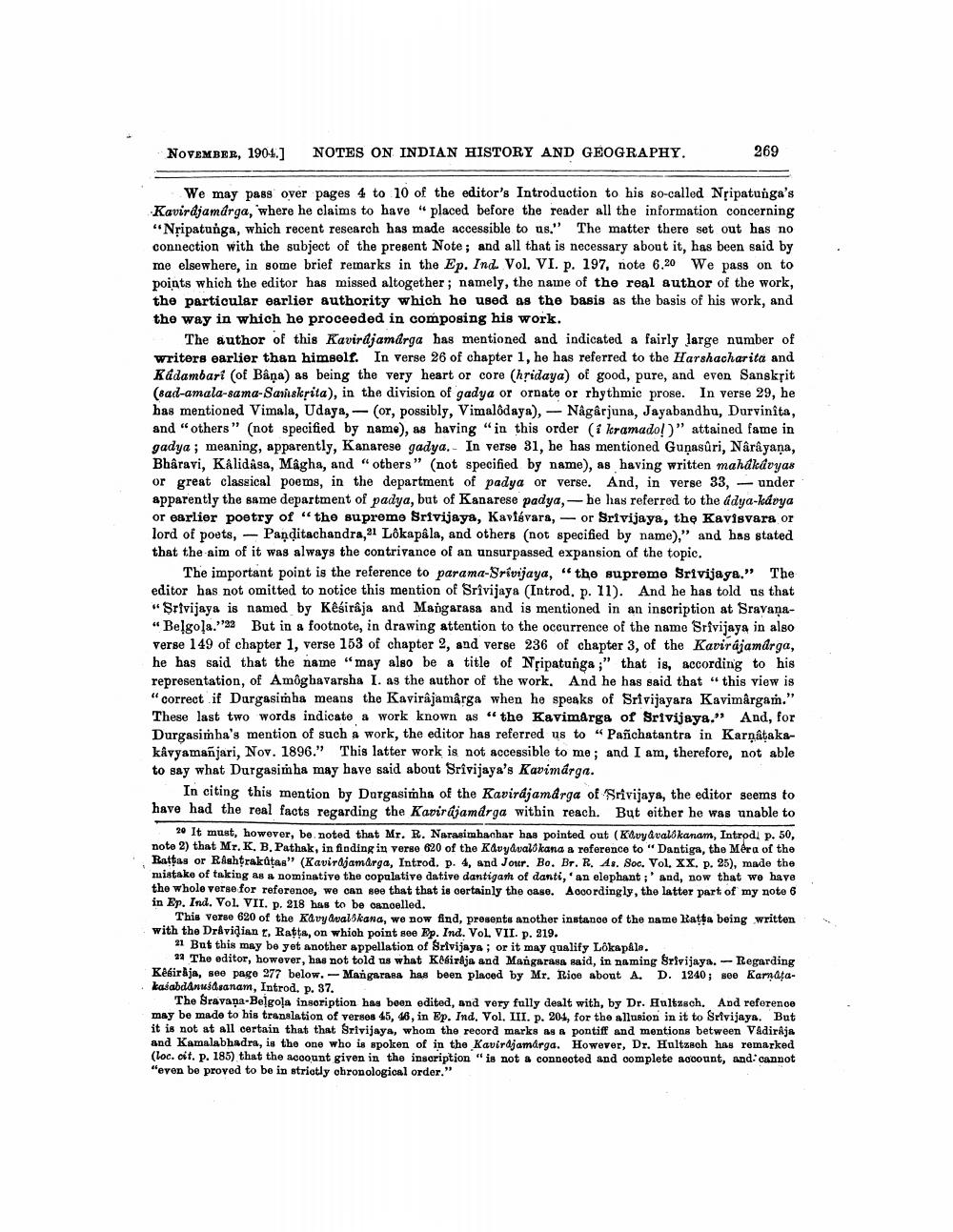________________
269
NOVEMBER, 1904.] NOTES ON INDIAN HISTORY AND GEOGRAPHY.
We may pass over pages 4 to 10 of the editor's Introduction to his so-called Nripatunga's Kavirajamarga, where he claims to have "placed before the reader all the information concerning "Nripatunga, which recent research has made accessible to us." The matter there set out has no connection with the subject of the present Note; and all that is necessary about it, has been said by me elsewhere, in some brief remarks in the Ep. Ind. Vol. VI. p. 197, note 6.20 We pass on to points which the editor has missed altogether; namely, the name of the real author of the work, the particular earlier authority which he used as the basis as the basis of his work, and the way in which he proceeded in composing his work.
The author of this Kavirajamarga has mentioned and indicated a fairly large number of writers earlier than himself. In verse 26 of chapter 1, he has referred to the Harshacharita and Kadambari (of Bâņa) as being the very heart or core (hridaya) of good, pure, and even Sanskrit (sad-amala-sama-Samskrita), in the division of gadya or ornate or rhythmic prose. In verse 29, he has mentioned Vimala, Udaya,- (or, possibly, Vimalôdaya), - Nâgârjuna, Jayabandhu, Durvinita, and "others" (not specified by name), as having "in this order (kramado!)" attained fame in gadya; meaning, apparently, Kanarese gadya. In verse 31, he has mentioned Gunasûri, Nârâyana, Bhâravi, Kâlidâsa, Mâgha, and "others" (not specified by name), as having written mahakavyas or great classical poems, in the department of padya or verse. And, in verse 33, - under apparently the same department of padya, but of Kanarese padya, he has referred to the ádya-kávya or earlier poetry of "the supreme Srivijaya, Kaviávara, -or Srivijaya, the Kavisvara or lord of poets, Panditachandra,21 Lôkapâla, and others (not specified by name)," and has stated that the aim of it was always the contrivance of an unsurpassed expansion of the topic.
The important point is the reference to parama-Srivijaya, "the supreme Srivijaya." The editor has not omitted to notice this mention of Srivijaya (Introd. p. 11). And he has told us that "Srivijaya is named by Kêśirâja and Mangarasa and is mentioned in an inscription at Sravana"Belgola."22 But in a footnote, in drawing attention to the occurrence of the name Srivijaya in also verse 149 of chapter 1, verse 153 of chapter 2, and verse 236 of chapter 3, of the Kavirájamarga, he has said that the name "may also be a title of Nripatunga;" that is, according to his representation, of Amôghavarsha I. as the author of the work. And he has said that "this view is "correct if Durgasimha means the Kavirajamârga when he speaks of Srivijayara Kavimârgaṁ." These last two words indicate a work known as "the Kavimarga of Srivijaya." And, for Durgasimha's mention of such a work, the editor has referred us to "Pañchatantra in Karnatakakavyamañjari, Nov. 1896." This latter work is not accessible to me; and I am, therefore, not able to say what Durgasimha may have said about Srivijaya's Kavimárga.
In citing this mention by Dargasimha of the Kavirajamarga of Srivijaya, the editor seems to have had the real facts regarding the Kavirajamarga within reach. But either he was unable to
20 It must, however, be noted that Mr. R. Narasimhachar has pointed out (Kavyavalokanam, Introd. p. 50, note 2) that Mr. K. B. Pathak, in finding in verse 620 of the Kavyavalokana a reference to "Dantiga, the Mera of the Rattas or Rashtrakutas" (Kavirajamarga, Introd. p. 4, and Jour. Bo. Br. R. As. Soc. Vol. XX. p. 25), made the mistake of taking as a nominative the copulative dative dantigam of danti,' an elephant; and, now that we have the whole verse for reference, we can see that that is certainly the case. Accordingly, the latter part of my note 6 in Ep. Ind. Vol. VII. p. 218 has to be cancelled.
This verse 620 of the Kavyavalikana, we now find, presents another instance of the name Ratta being written with the Dravidian r, Ratta, on which point see Ep. Ind. Vol. VII. p. 219.
21 But this may be yet another appellation of Srivijaya; or it may qualify Lôkapala.
22 The editor, however, has not told us what Kêéiraja and Mangarasa said, in naming Srivijaya. Regarding Kêsiraja, see page 277 below. - Mangarasa has been placed by Mr. Rice about A. D. 1240; see Karnatakasabdanusasanam, Introd. p. 37.
The Sravana-Belgola inscription has been edited, and very fully dealt with, by Dr. Hultzsch. And reference may be made to his translation of verses 45, 46, in Ep. Ind. Vol. III. p. 204, for the allusion in it to Srivijaya. But it is not at all certain that that Srivijaya, whom the record marks as a pontiff and mentions between Vadiraja and Kamalabhadra, is the one who is spoken of in the Kavirajamarga. However, Dr. Hultzsch has remarked (loc. cit. p. 185) that the account given in the inscription "is not a connected and complete account, and: cannot "even be proved to be in strictly chronological order."




